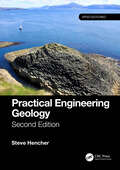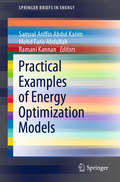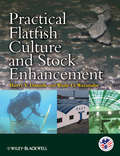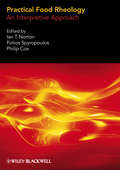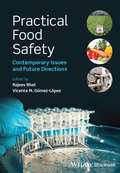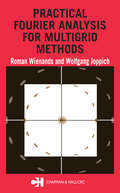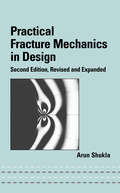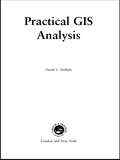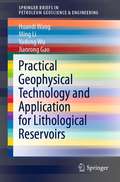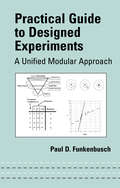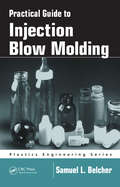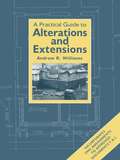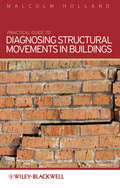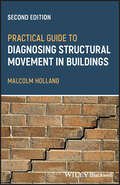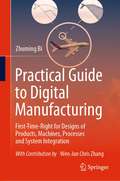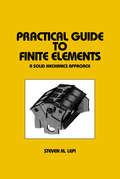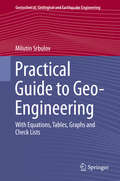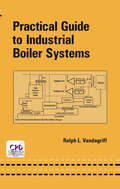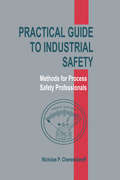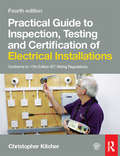- Table View
- List View
Practical Engineering Geology (Applied Geotechnics)
by Steve HencherPractical Engineering Geology provides an introduction to the way projects are managed, designed and constructed, and how the engineering geologist can contribute to cost- effective and safe project achievement. The need for a holistic view of geological materials, from soil to rock, and of geological history is emphasised. Chapters address key aspects of• Geology for engineering and ground modelling• Site investigation and testing of geological materials• Geotechnical parameters• Design of slopes, tunnels, foundations, and other engineering structures• Identifying hazards• Avoiding unexpected ground conditionsThis second edition includes a new chapter on environmental issues covering hydrogeology, considerations of climate change, earthquakes, and more. All chapters have been updated, with extensively revised figures throughout and several new case studies of unexpected ground conditions. The book will support practising engineering geologists and geotechnical engineers, as well as MSc level students of engineering geology and other geotechnical subjects.
Practical Environmental Bioremediation: The Field Guide, Second Edition
by R. Barry King John K. Sheldon Gilbert M. LongBioremediation, or enhanced microbiological treatment, of environments contaminated with a variety of organic and inorganic compounds is one of the most effective innovative technologies to come around this century! Practical Environmental Bioremediation: The Field Guide presents updated material, case histories and many instructive illustrations to reflect the evolving image of this fast-emerging industry. Bioremediation technology has witnessed great strides towards simplifying treatability formats, finding new approaches to field application, more potent nutrient formulations, monitoring protocols and the resulting general improvement in results. This new guide condenses all current available knowledge and presents necessary technical aspects and concepts in language that can be readily comprehended by the technical student, experienced scientist or engineer, the aspiring newcomer, or anyone else interested in this exciting natural cleanup technique.
Practical Ethics for Food Professionals: Ethics in Research, Education and the Workplace (Institute of Food Technologists Series #52)
by J. Peter Clark Christopher RitsonThis book offers a practical guide to the most pressing ethical issues faced by those working in food manufacturing and associated industries. Early chapters look at the fundamentals of ethical thinking and how lessons of medical ethics might be applied to the food industry. The book then addresses some issues specifically relevant to the food industry, including treatment of animals; the use of genetically modified organisms; food product advertising; health claims and sustainability. Several further chapters present case studies which show how ethical thinking can be applied in real life examples. This volume should be on the desk of every food industry professional responsible for important decisions about science, marketing, resources, sustainability, the environment and people.
Practical Examples of Energy Optimization Models (SpringerBriefs in Energy)
by Ramani Kannan Samsul Ariffin Abdul Karim Mohd Faris AbdullahThis book highlights state-of-the-art research on renewable energy integration technology and suitable and efficient power generation, discussing smart grids, renewable energy grid integration, prediction control models, and econometric models for predicting the global solar radiation and factors that affect solar radiation, performance evaluation of photovoltaic systems, and improved energy consumption prediction models. It discusses several methods, algorithms, environmental data-based performance analyses, and experimental results to help readers gain a detailed understanding of the pros and cons of technologies in this rapidly growing area. Accordingly, it offers a valuable resource for students and researchers working on renewable energy optimization models.
Practical Extrusion Blow Molding (Plastics Engineering Ser. #54)
by SamuelL. BelcherOutline proven methods from planning and manufacture to product testing, this work reports on the most effective means of producing plastics by the extrusion blow moulding process. It supplies data on materials, performance standards and testing methodologies developed in industry with proven reliability and cost effectiveness.
Practical Fiber Optics
by Edwin Wright David BaileyThis book gives both the novice and the experienced user a solid grasp of the principles and practical implementation of fiber optic cabling for industrial applications.
Practical Field Robotics
by Robert H. Sturges JrPractical Field Robotics: A Systems Approach is a comprehensive reference that takes the reader through the whole process of field robotics, starting from the beginning 'problem statement' to the end 'project demonstration'. It takes a practical approach, showing precisely how to realize a working robotic system, and bridges the gap between existing mathematically based texts and the real work that goes on in research labs all over the world.Practical Field Robotics: A Systems Approach includes an overview of field robotics and a detailed examination of hardware and software design. It also covers the equipment requirements, conceptual and operational designs, and safety and reliability for multiple field robots, including those used in nuclear service, underground mining and mowing.Problems are included with additional problems and supporting videos available on a companion website.
Practical Flatfish Culture and Stock Enhancement (United States Aquaculture Society series)
by H. V. Daniels W. O. WatanabePractical Flatfish Culture and Stock Enhancement is a key reference on culture methods, offering both practical applications and essential biological information. Throughout the text, the culture and stock enhancement issues are treated simultaneously, integrating these two perspectives. By looking to the outcomes of hatchery culture methods, including the economics and fish behavior, Practical Flatfish Culture and Stock Enhancement is a valuable tool in making management decisions. With chapters on disease diagnosis and treatment, culture methods for a number of specific species, and the use of flatfish as model organisms in laboratory settings, Practical Flatfish Culture and Stock Enhancement comprehensively covers the subject of culture and stock enhancement. The book is especially useful for aquaculture professionals, industry personnel, researchers, biologists, and aquaculture and fisheries management students.
Practical Food Rheology: An Interpretive Approach
by Ian NortonRheology is fundamentally important in food manufacturing in two major senses. Understanding the way in which a substance moves and behaves is essential in order to be able to transport and mix it during processing. Secondly, the rheology of a product dictates much of the consumer experience, e.g. in relation to texture and mouthfeel. This book doesn’t overwhelm the reader with complex mathematical equations but takes a simple and practically-focused approach, interpreting the implications of rheological data for use in different food systems. Through this approach industry-based food developers / rheologists, students, and academics are given clear, concise interpretation of rheological data which directly relates to actual perceived functionality in the food. The functionality may relate to texture, structure and mouthfeel, and may result as a function of temperature, pH, flocculation, concentration effects, and mixing. The interpretative view is based on the principle that the food rheologist will produce a graph, for example of viscosity or gelation profiling, and then have to extract a practical meaning from it. For example, if viscosity falls with time as a function of pH, this knowledge can be used to tell the customer that the viscosity can be followed with just a pH meter and a stopwatch. Rheological measurements have shown that once the pH has dropped 1 unit after 10 minutes, the viscosity has been halved. This is the type of practical and valuable information for customers of the industrial food rheologist which the book will enable readers to access. Key features: A uniquely practical approach to the often difficult science of food rheology Includes chapters introducing the basics of food rheology before moving on to how data can be usefully and easily interpreted by the food scientist Can be used as a teaching aid on academic or industry-based courses
Practical Food Safety: Contemporary Issues and Future Directions
by Vicente M. Gómez-López Rajeev BhatThe past few years have witnessed an upsurge in incidences relating to food safety issues, which are all attributed to different factors. Today, with the increase in knowledge and available databases on food safety issues, the world is witnessing tremendous efforts towards the development of new, economical and environmentally-friendly techniques for maintaining the quality of perishable foods and agro-based commodities. The intensification of food safety concerns reflects a major global awareness of foods in world trade. Several recommendations have been put forward by various world governing bodies and committees to solve food safety issues, which are all mainly targeted at benefiting consumers. In addition, economic losses and instability to a particular nation or region caused by food safety issues can be huge. Various ‘non-dependent’ risk factors can be involved with regard to food safety in a wide range of food commodities such as fresh fruits, vegetables, seafood, poultry, meat and meat products. Additionally, food safety issues involves a wide array of issues including processed foods, packaging, post-harvest preservation, microbial growth and spoilage, food poisoning, handling at the manufacturing units, food additives, presence of banned chemicals and drugs, and more. Rapid change in climatic conditions is also playing a pivotal role with regard to food safety issues, and increasing the anxiety about our ability to feed the world safely. Practical Food Safety: Contemporary Issues and Future Directions takes a multi-faceted approach to the subject of food safety, covering various aspects ranging from microbiological to chemical issues, and from basic knowledge to future perspectives. This is a book exclusively designed to simultaneously encourage consideration of the present knowledge and future possibilities of food safety. This book also covers the classic topics required for all books on food safety, and encompasses the most recent updates in the field. Leading researchers have addressed new issues and have put forth novel research findings that will affect the world in the future, and suggesting how these should be faced. This book will be useful for researchers engaged in the field of food science and food safety, food industry personnel engaged in safety aspects, and governmental and non-governmental agencies involved in establishing guidelines towards establishing safety measures for food and agricultural commodities.
Practical Fourier Analysis for Multigrid Methods (Numerical Insights)
by Roman Wienands Wolfgang JoppichBefore applying multigrid methods to a project, mathematicians, scientists, and engineers need to answer questions related to the quality of convergence, whether a development will pay out, whether multigrid will work for a particular application, and what the numerical properties are. Practical Fourier Analysis for Multigrid Methods uses a detaile
Practical Fracture Mechanics in Design
by Arun ShuklaTheoretical treatments of fracture mechanics abound in the literature. Among the first books to address this vital topic from an applied standpoint was the first edition of Practical Fracture Mechanics in Design. Completely updated and expanded to reflect recent developments in the field, the second edition of this valuable reference concisely revi
Practical GIS Analysis
by David L. VerbylaThe hard part of problem solving using GIS analysis is the selection of the proper tools. The only practical guide for solving geo-spatial problems independent of specific GIS software and hardware, Practical GIS Analysis will teach you how GIS tools work, and how you can use them to solve problems in both vector and grid GIS worlds. The book inclu
Practical Geophysical Technology and Application for Lithological Reservoirs (SpringerBriefs in Petroleum Geoscience & Engineering)
by Ming Li Huandi Wang Yadong Wu Jianrong GaoThis book introduces new geological analysis and geophysical methods and techniques for lithological reservoir exploration. It puts forward a set of practical geophysical methods and techniques aimed at lithological reservoirs in China. From a practical point of view, the book systematically analyses geophysical methods and technique principles, applied steps, key problems and caution notes in lithological exploration. The lessons of the book are demonstrated with a case study of the Songliao Basin, which has a large area with a low density of lithological reservoirs, indicating the methods and techniques that can identify lithological reservoirs. It is unique in its fusion of theory, method and technology and practice.
Practical Guide To Designed Experiments: A Unified Modular Approach (Mechanical Engineering)
by Paul D. FunkenbuschMany engineers and scientists have receive little or no training in designed experiments, and any courses that are available tend to be either abstract and divorced from practical considerations or strictly practical-lacking the rigor and depth necessary for true, long-term understanding.Practical Guide to Designed Experiments: A Unified Mo
Practical Guide To Injection Blow Molding (Plastics Engineering #71)
by Samuel L. BelcherTaking a straight-forward approach, the Practical Guide to Injection Blow Molding explores the entire industry from conception, design, costing, tooling, and machinery, to trouble-shooting, testing, and daily production. With information for both the novice investor and the plastic industry expert, this concise text is reinforced with pictures, charts, and figures. The author, a highly knowledgeable industry insider, and a member ofThe Plastics Hall of Fame, discusses the history of the industry, as well as its daily workings. He instructs in product and tooling design, as well as material and machine selection, explaining advantages and disadvantages, elaborating on efficiencies that can be realized.
Practical Guide to Alterations and Extensions
by Andrew R. WilliamsThis simple-to-use, practical guide to altering or extending property is invaluable to all those who are trying to ensure that the processes involved are carried out efficiently and cost-effectively. For those working or planning to work in the construction industry, it will remind them of the pitfalls of local requirements, building control and planning.
Practical Guide to Diagnosing Structural Movement in Buildings
by Malcolm Holland"What's the Crack?" When cracking is observed in a building the most common reaction is that it must be the foundations and that it must be serious. Many surveyors are nervous about diagnosing cracks. This is understandable, as the interpretation of cracks can be difficult to teach, with university courses providing little or no time for field experience. Yet by understanding one straightforward principle the majority of cracks can be diagnosed in just a few minutes. Linking this with a good knowledge of construction techniques, the factors that distort cracking patterns and the key features of common causes of cracking, almost all cracks can be diagnosed quickly and with confidence. Practical Guide to Diagnosing Structural Movement in Buildings provides a methodology by which cracks and movement in buildings can be diagnosed. Written in four parts, part one describes the key principles of movement and cracking. Parts two and three describe the main features of common forms of movement and the associated crack patterns. Part two covers causes other than ground or foundation movement and part three covers movement caused by ground or foundation problems. Part four briefly describes the techniques used to arrest further movement or repair damage cause by movement. Primarily intended for the relatively inexperienced surveyor or engineer and undergraduate students of surveying as a practical guide for use on site, it focuses on identification and diagnosis. It will not only help in correctly diagnosing the problem but it will also demonstrate a methodical approach to show and record how the diagnosis was reached – critical when giving advice to third parties. "What's the crack?" - In the vast majority of cases it's not foundation related and in most cases it's not indicating a serious defect.
Practical Guide to Diagnosing Structural Movement in Buildings
by Malcolm HollandPRACTICAL GUIDE TO DIAGNOSING STRUCTURAL MOVEMENT IN BUILDINGS Concise and readable practitioner focused guide to diagnosing the causes of cracks and movement in buildings The expanded and updated Second Edition of Practical Guide to Diagnosing Structural Movement in Buildings shows how movement can manifest as cracking in the building fabric and provides a rigorous, structured approach to understanding the evidence to ensure the surveyor can confidently diagnose the cause and impact of any structural movement they encounter. The book is written in four parts, with part one describing the key principles of movement and cracking. Parts two and three describe the main features of common forms of movement and the associated crack patterns, with part two covering causes other than ground or foundation movement and part three covering movement caused by ground or foundations. Part four briefly describes the techniques used to arrest further movement or repair damage caused by movement. Topics covered in Practical Guide to Diagnosing Structural Movement in Buildings include: First principles, including crack patterns and cracks, rotational movement, weak routes, load distribution, and movement and orientation Expansion cracking, cavity wall tie corrosion, roof spread, springing from deflected beams, and overloaded floors and beams Clay heave, uneven loading, eccentric loading on foundations, drains and drain trenches, differential foundation movement, and load concentrations on foundations Repair methods, including stitching in brickwork, reinforcing brick mortar joints, tie bars, restraint straps, underpinning, grouting, and root barriers Primarily intended for the relatively inexperienced surveyor or engineer, as well as undergraduate students, Practical Guide to Diagnosing Structural Movement in Buildings focuses on identification and diagnosis, helping to correctly diagnose problems while also demonstrating a methodical approach to show and record how the diagnosis was reached, which is critical in client satisfaction.
Practical Guide to Digital Manufacturing: First-Time-Right for Design of Products, Machines, Processes and System Integration
by Zhuming BiThis book covers the subject of digital manufacturing. It provides a practical guide for readers on using computer aided design (CAD), computer aided engineering (CAE) and computer aided manufacturing (CAM) and other computer assistive tools for the design of products, machines, processes and system integrations through the case studies of engineering projects. The book introduces a thorough theoretical foundation and discussion of the historical development, and enabling technologies of digital manufacturing. It also covers a broad range of computer aided tools for a variety of applications including: geometric modelling;assembly modelling;motion simulation;finite element analysis;manufacturing process simulation;machining programming;product data management; and,product lifecycle management. Practical Guide to Digital Manufacturing uses many real-world case studies to illustrate the discussed applications, making it easily readable for undergraduate and graduate students, as well as engineers with the needs of computer-aided design and manufacturing knowledge and skills.
Practical Guide to Finite Elements: A Solid Mechanics Approach
by Steven LepiAssuming only basic knowledge of mathematics and engineering mechanics, this lucid reference introduces the fundamentals of finite element theory using easy-to-understand terms and simple problems-systematically grounding the practitioner in the basic principles then suggesting applications to more general cases.Furnishes a wealth of practical insights drawn from the extensive experience of a specialist in the field!Generously illustrated with over 200 detailed drawings to clarify discussions and containing key literature citations for more in-depth study of particular topics, this clearly written resource is an exceptional guide for mechanical, civil, aeronautic, automotive, electrical and electronics, and design engineers; engineering managers; and upper-level undergraduate, graduate, and continuing-education students in these disciplines.
Practical Guide to Geo-Engineering
by Milutin SrbulovThis handy reference manual puts a wealth of ready-to-use information, data, and practical procedures within immediate reach of geo-engineers and technicians, whether they be in the field or office. It assembles and organizes the most-needed set of equations, tables, graphs and check-lists on six major subfields of geo-engineering: investigations, testing, properties, hazards, structures and works. This practical reference for the professional and others interested in the subject of ground engineering skips lengthy definitions to highlight best practice and methods proven most effective. While reflecting codes and standards, it also fills the gaps with non-standard approaches when existing ones are skimpy on practical details or agreement. Enhanced by 146 illustrations and 83 tables, the Practical Guide to Geo-Engineering points users to supporting information and data through its extensive reference list. Audience: This book is of interest to everyone involved in practical geo-engineering.
Practical Guide to Industrial Boiler Systems
by Ralph VandagriffThis volume covers the fundamentals of boiler systems and gathers hard-to-find facts and observations for designing, constructing and operating industrial power plants in the United States and overseas. It contains formulas and spreadsheets outlining combustion points of natural gas, oil and solid fuel beds. It also includes a boiler operator's tra
Practical Guide to Industrial Safety: Methods for Process Safety Professionals
by Nicholas P. CheremisinoffA practical guide to industrial safety. It seeks to assist specialists in managing operations in industrial settings, including high-risk personal exposure such as inhalation hazards and direct chemical contact. It covers hazards in the chemical process industries, inhalation hazards in refineries, indoor air quality management, personal protective
Practical Guide to Inspection, Testing and Certification of Electrical Installations
by Christopher KitcherFull coverage of testing and inspection methods, helping you to pass City & Guilds, EAL, AM2 and other related assessments Entirely up to date with the Third Amendment of the 17th Edition IET Wiring Regulations amendments Step-by-step descriptions, photos and online videos of the tests show exactly how to carry them out Covers City & Guilds 2394, 2395, 2396, EAL 600/4338/6 and 600/4340/4, and Part P assessments This book covers everything students need to learn about inspection and testing in order to pass their exams, containing clear reference to the latest legal requirements. All of the theory required in order to pass the City & Guilds 2394, 2395 and 2396 certificates, EAL 600/4338/6 and 600/4340/4 is explained in clear, easy to remember language along with sample questions and scenarios as encountered in the exams. It will also help prepare students on Part P Competent Person courses, City & Guilds Level 3 courses, NVQs and apprenticeship programmes for their practical inspection and testing exam. With its focus on the practical side of inspection and testing rather than just the requirements of the regulations, this book is ideal for students, experienced electricians and those working in allied industries on domestic and industrial installations.
